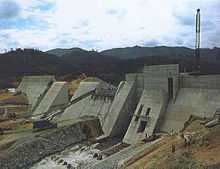Kihansi Dam
| Kihansi Dam | |
|---|---|
 Kihansi Dam (2005) | |
| Official name | Kihansi Dam |
| Location | Mufindi District, Iringa Region, Tanzania |
| Coordinates | 8°34′30″S 35°51′04″E / 8.5751°S 35.8512°ECoordinates: 8°34′30″S 35°51′04″E / 8.5751°S 35.8512°E |
| Construction began | 1995 |
| Opening date | 2000 |
| Construction cost |
$36,268,726 (dam and related works) $ 9,067,185 (access and service road) |
| Operator(s) | TANESCO |
| Dam and spillways | |
| Impounds | Kihansi River |
| Height | 25 m (82 ft) |
| Length | 404 m (1,325 ft) |
| Width (base) | 201 m (659 ft) |
| Reservoir | |
| Creates | Kihansi Reservoir |
| Total capacity | 0.001 km3 (810 acre·ft) |
| Surface area | .1 sq mi (0.26 km2)[1] |
| Power station | |
| Turbines | 3 Main |
| Installed capacity | 180 MW (240,000 hp) |
| Annual generation | 340 GWh (1,200 TJ) |
Kihansi Dam is a hydroelectric dam located on the Kihansi River at the end of the Kihansi Gorge before the convergence with the Ulanga River in Tanzania approximately 450 kilometres (280 mi) southwest of Dar Es Salaam.
Overview
The Kihansi Dam is a concrete gravity dam owned by the Tanzania Electric Supply Company Limited. Its construction began in July 1995 and was opened by President Benjamin W. Mkapa on 10 July 2000. It cost $36 million. Its installed capacity is 180 MW, and it helps provide approximately 13% of the total electrical power in Tanzania.[1][2][3]
Environmental impact
The Kihansi Dam destroyed an 800m-high waterfall, affected over 20,000 villagers, and was directly responsible for the extinction in the wild of the Kihansi Spray Toad. The dam reduced the amount of silt and water coming down from the waterfall into the gorge by 90 percent. This led to the spray toad's microhabitat being compromised, as it reduced the amount of water spray, which the toads were directly reliant on for oxygen. This also meant that the toad may have been more susceptible to a chytrid fungus, which was believed to have been transported to the area by conservationists' boots. This chytridiomycosis, which in 2003 was confirmed to be in dead animals of the species, was possibly responsible for the sudden population crash after the world's largest sprinkler system was installed in that area in August 2003. This system was installed to try and conserve the toad species from becoming extinct in the wild, but did not succeed.[4][5]
References
- ↑ 1.0 1.1 "Lower Kihansi Hydropower Dam and Reservoir Project, Tanzania".
- ↑ Myrvoll, Frank; S. B. Hansen; J. A. Roti; A. Halvorsen (2003). Frank Myrvoll, ed. Field Measurements in Geomechanics. Taylor & Francis. pp. 245–254. ISBN 978-90-5809-602-- 9. Retrieved 2010-05-16.
- ↑ Pierre Julien; Seema Shah (2005-11-01). "Sedimentation Initiatives in Developing Countries". UNESCO. pp. 29–31. Retrieved 2010-05-16.
- ↑
- ↑ "Species' extinction threat grows". BBC. 2009-11-03. Retrieved 2010-05-07.